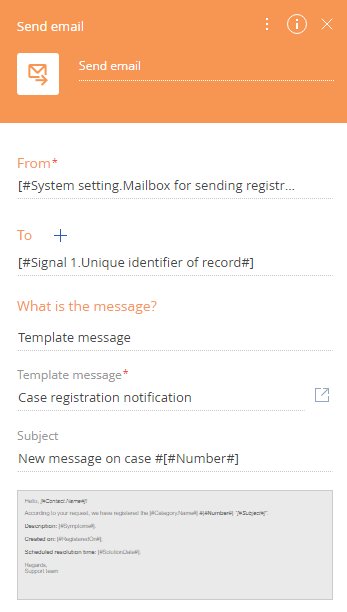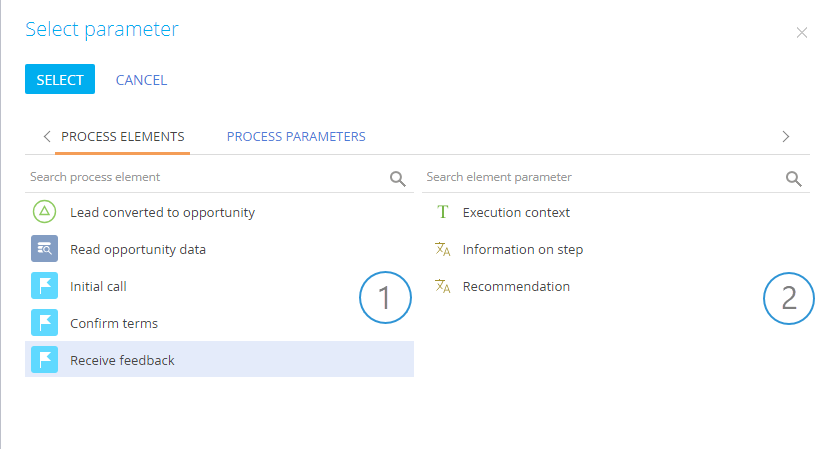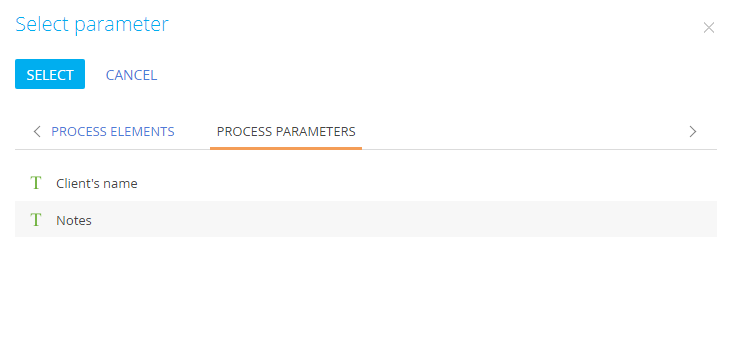Process parameters
Every process task requires some form of input, e. g, the date and time of a meeting, task assignee, customer’s contact, etc. Also, it is often necessary to exchange data between elements within the same business process (e. g., sending an email to the same contact that was specified in the meeting), as well as between different processes (e. g., branching a process depending on the result of its sub-process).
The following table outlines common business tasks from the standpoint of process execution mechanisms in Creatio:
Business task | Creatio task | Process task |
|---|---|---|
Schedule a task and make it easily identifiable in the calendar | Create a new record in the Activities section with a certain value in the Subject field | Manually enter the title of the task that must be created as the value of the What should be done? parameter of the Perform task element. |
Assign a task to the user who started the process | The Owner field of the record in the Activities section should be populated with the current user contact | Set the "Current user contact" variable as the value of the Who performs the task? parameter of the Perform task element. |
Email the meeting contact immediately after the meeting has ended | Create a new email whose To field will contain the email address of a contact who was specified in the Contact field of the meeting activity | The To parameter of the Send email element must have the same value as the Contact parameter of the Perform task element. |
Check Creatio marketplace for free business process templates (Fig. 1, Fig. 2, Fig. 3, Fig. 4, Fig. 5) illustrating the examples of using process parameters. Download the template.
After you install the template, two new processes will appear in the Process library section: "Call a client" and "CEO review" processes. Select a process and click Open to view its diagram. The business process examples mentioned in this article will be available in these two processes.





Creatio uses parameters to solve the aforementioned process tasks.
Parameters
Parameters are similar to fields on Creatio record pages: they can be populated with values of different data types (text, numerical, lookup, etc.). In Creatio, business process parameters serve two functions:
- Provide specifics (or "input") about how the process elements are executed (e. g., what will be the name and duration of an activity created as part of a business process, who will be assigned as its owner, etc.).
- Act as a medium for exchanging information between the elements within a business process (e. g., what the task result was, who its owner was, etc.) or between a sub-process and its parent process.
Since parameters represent the state of a process element or a process after its execution is complete, their values can be used for branching processes using gateways and conditional flows.
Parameters are available in both business processes and process elements.
Element parameters are displayed on the element setup area. For example, the To field in the Send Email process element (Fig. 6) is a text parameter whose value represents the recipient’s email address.

Important element parameters are available on the element’s setup area by default, whenever you select an element on the diagram. If the element setup area is closed, simply double-click the element to open it. To access all parameters of an element, switch to the advanced mode (Fig. 7).
The names of parameters in the regular and advanced modes may be different. To locate which parameter is being populated, type in a random value for the necessary parameter in the "regular" mode, switch to the "advanced" mode and locate the value in the list of parameters.
Process parameters are available on the Parameters tab in the process setup area (Fig. 8), which you can access by clicking  or empty space on the Process Designer working area (if the element setup area is open).
or empty space on the Process Designer working area (if the element setup area is open).

Parameter types
The type of parameter depends on the data type of its value. The types of parameters are roughly similar to types of Creatio section and lookup columns, which in turn correspond to columns in the Creatio database.
The following parameter types are available in Creatio:
Parameter type | Description |
|---|---|
| A parameter whose value is a text string that can represent a constant value or a value generated during the process flow. For example, the What should be done? parameter of the Perform task element. |
| Stores and exchanges decimal numeric values. For example, the Function result parameter of the Read data element. |
| Stores and exchanges integer numeric values. For example, the Start executing in parameter of the Perform task element. |
| Stores logical values (true or false). For example, the Answer required parameter in the User dialog element. |
| A parameter that stores a value from a lookup (i.e., a link to a lookup record). For example, the Who fills in the page? parameter of the Open edit page element can be populated with values from the Contact lookup. |
| Stores certain date/time values. For example, the Start date and time parameter of the Start timer event. |
| Stores values of currency fields. Learn more: Work with currencies. |
| Collection parameter contains complex values, each representing several entries, such as several contacts with name, address, and a phone number specified for each contact. For example, developers can use this parameter in the Pre-configured page element. |
| Stores a unique record identifier. For example, the Id parameter of the Signal start event. |
Depending on when and how a parameter value is populated, it can be either input or output.
- Input values are populated before the element or process is executed. Input parameters affect the process element execution.
- Output values are populated during the process/element execution and usually represent its result, or the state the process or element is in after it has been completed.
An input value can be replaced with an output value in some parameters, e. g., a task was connected to a specific contact but needs to be replaced with a different contact during process execution.
Populate parameter values
You can populate input parameter values in one of the following ways:
- Enter a static parameter value manually. In this case, parameter values are specified directly, when the process is designed and are always the same in all process instances. For example, the name of the task (the What should be done? parameter) was created with the help of the Perform task element.
- Select a system setting (e. g., "Test email recipient") or a system variable (e. g., current date and time, current user contact, current user account, etc.) whose value will be passed to the parameter. In this case, parameter values will be the same as the values of corresponding system settings or system variables at the time of process execution. For example, if you select the current user contact as the Who performs the task? parameter value in the Perform task element, the task will be created for the user who started the process.
- Use a formula. Multiple parameters can be combined or converted to other types using formula syntax, e. g., combining a text string with a parameter value.
- By obtaining a value from another parameter. This method enables you to get a parameter value from a different parameter in the process. For example, you can get the contact with whom the meeting had been previously scheduled (the Contact parameter of the Perform task element) and pass this value to the To parameter of the Send Email element.
Learn more: Use process parameters.
Obtain parameter values from another parameter
A parameter can be configured to obtain its input value from another parameter with the same data type.
For example, a new contact is added via an Open edit page element, and later in the process flow, a meeting must be scheduled with that same contact. In this case, the value of the source Record Id parameter (where the record Id of the contact is stored) of the Open edit page element must be passed to the target Contact parameter of the Perform task element.
Make sure that the source parameter is properly populated at the time when the target parameter obtains its value.
Most of the time, parameters can only receive values from other parameters of the same type. However, certain parameters can receive values of other parameter types, namely:
- Date/time parameters can store interchangeable values: you can specify a date value in the time parameter and vice versa.
- Integer and decimal parameters can store interchangeable values, i.e. you can specify a decimal value in the integer parameter and vice versa. Integer and decimal values will be converted depending on the parameter they are passed to.
- Lookup parameters can store a record’s unique identifier (Id). For example, specify the Id of a contact in a lookup parameter whose values can be selected from the Contacts lookup.
To obtain a parameter value from a different parameter:
-
Click the
 button next to the field of the "target" parameter (the one, which must be populated).
button next to the field of the "target" parameter (the one, which must be populated). -
Select Process parameter from the menu (Fig. 9). The parameter selection window (Fig. 10) will open.
Fig. 9 Open the process parameter selection window 
Select a source process or element parameter (the one, whose value must be passed to the current parameter) in the parameter selection window.
-
The Process elements tab (Fig. 10) of the parameter selection window displays a list of elements in the current process (1). Select an element on the left-hand side of the window and the list of its parameters will be displayed to the right (2). This list only displays parameters whose type corresponds to the target parameter. Double-click a parameter in the list to populate the target parameter with its value.
Fig. 10 The element parameter selection tab 
The Process parameters tab (Fig. 11) displays all available process parameters. This list only displays parameters whose type corresponds to the target parameter. Double-click a parameter in the list to populate the target parameter with its value.

 Text
Text Decimal
Decimal Integer
Integer Boolean
Boolean Lookup
Lookup Date/Time
Date/Time Currency
Currency Collection of records
Collection of records Id
Id